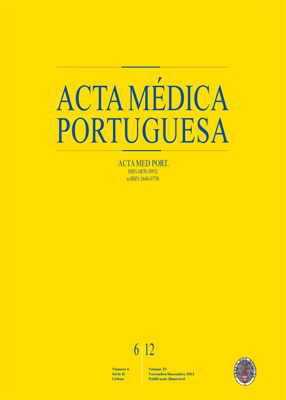Cerebral Creatine Deficiency Syndromes
DOI:
https://doi.org/10.20344/amp.1355Abstract
Introduction: Creatine deficiency syndromes are a recently described group of diseases characterized by inborn errors of creatinemetabolism. Clinical features include a spectrum of neurodevelopment disorders of diverse severity. They are characterized by lowlevels of cerebral creatine caused by different pathogenic mutations concerning the genes coding for creatine synthesis enzymes[arginine: glicyne amidinotransferase (AGAT, EC 2.1.4.1) and guanidinoacetate methyltansferase (GAMT, EC 2.1.1.2)], AGAT andGAMT, respectively, or its transporter (CT1 deficiency), SLC6A8. Enzymatic deficiencies are transmitted as autosomal recessive traits,whereas the transporter deficit is X-linked.Objectives: To characterize the clinical and laboratorial presentation, diagnosis and treatment of cerebral creatine deficiency patients,followed in Hospital Pediátrico Carmona da Mota. The awareness of these inborn errors of metabolism as neurological disorders,namely of neurodevelopment, among the medical community is a secondary aim of the present work.Methods and Material: Retrospective analysis of the clinical files of patients followed in our Hospital and diagnosed with cerebralcreatine deficiency syndrome.Results: Twelve patients belonging to seven different families were diagnosed with creatine deficiency syndromes. Five presentedGAMT deficiency and seven CT1 deficiency. Present ages are 2 to 38 years old. The most common clinical presentations were: globaldevelopment delay in seven patients (two with epilepsy), and speech delay in two patients. Only one patient had communication andsocial interaction dysfunction. In all, global development delay in the range of intellectual delay was identified. The pathognomonic patternof cerebral creatine deficiency in the brain image was demonstrated in eight patients. Pathogenic mutations in GAMT or SLC6A8genes were identified in all cases.Conclusions: The suspicion of cerebral creatine depletion must be considered in all children presenting unexplained global psychomotordevelopment delay. Pre-symptomatic therapy has shown promising results, especially in GAMT deficiency patients. The high rate ofasymptomatic carriers of GAMT mutations in our population makes this disorder eligible to neonatal screening in Portugal.
Downloads
Downloads
Published
How to Cite
Issue
Section
License
All the articles published in the AMP are open access and comply with the requirements of funding agencies or academic institutions. The AMP is governed by the terms of the Creative Commons ‘Attribution – Non-Commercial Use - (CC-BY-NC)’ license, regarding the use by third parties.
It is the author’s responsibility to obtain approval for the reproduction of figures, tables, etc. from other publications.
Upon acceptance of an article for publication, the authors will be asked to complete the ICMJE “Copyright Liability and Copyright Sharing Statement “(http://www.actamedicaportuguesa.com/info/AMP-NormasPublicacao.pdf) and the “Declaration of Potential Conflicts of Interest” (http:// www.icmje.org/conflicts-of-interest). An e-mail will be sent to the corresponding author to acknowledge receipt of the manuscript.
After publication, the authors are authorised to make their articles available in repositories of their institutions of origin, as long as they always mention where they were published and according to the Creative Commons license.









